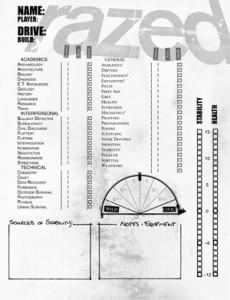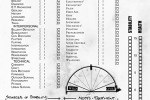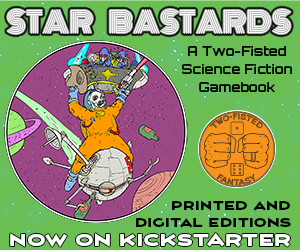Razed
Razed is a complete game powered by the GUMSHOE system and published by Pelgrane Press.
By Will Hindmarch

Welcome to the fourteenth Designer’s Diary, a regular column where designers are given the opportunity to take readers on an in-depth ride through the design and development process of their system, setting, or product.
Designer’s Description
Razed is a post-apocalyptic survival and investigation game using the famed GUMSHOE rules system, well known to players of The Esoterrorists and Trail of Cthulhu and the like. Part of what makes Razed unique, though, is the malleability of the setting and the mystery at its core. At the heart of a typical Razed campaign is the question, “Who killed planet Earth?” The post-apocalyptic landscape is like a crime scene and suspects abound. Was it marauding space aliens? Was it human hubris? Was it a fluke of nature? Razed campaigns reveal that answer during play, along with the truths behind lots of other, smaller mysteries like “Who stole our water supply?” and “Where did my family get evacuated to?”
The game has changed a bit since I first started developing it. Where once it was set long after an apocalyptic alien invasion, now the game is set up with “dials” that let you adjust the main conceits of the setting easily, as you would with a fantasy RPG, recasting the main elements of the setting in new ways. Use the core pieces of the game world—like space aliens and mysterious machines—to create your own unique setting for play.
I’ve taken to saying that the game is less post-apocalyptic and more apocalyptic—the events of the apocalypse are often still ongoing in a Razed campaign. Civilization is in flux. We still have a fighting chance at survival, provided we’re smart and strong.
Purpose
I sort of came at Razed backwards, actually. I really wanted to design a GUMSHOE game and was happily invited to pitch a few ideas to Simon Rogers at Pelgrane Press. Razed was just one of several options I offered up, but it’s the one that caught on with Simon and Robin D. Laws, so it’s the one I’ve been pursuing. I pitched it, though, not because I really wanted to design it but because I wanted to read it. I thought it was a great medium for an investigative game and I thought having this big question at the heart of the campaign could be a fitting bit of fun for the system.
Since it’s fallen to me to design and develop Razed, though, I’ve made it into a vision that I’m excited about, drawing on the apocalyptic tales I enjoy (or am most moved by), rather than some of the common standouts in the genre. You can play something with fast cars and spiky armor with this game, but it’s aimed more at the ilk of The Terminator and War of the Worlds. That said, part of my goal is to make Razed‘s setting as modular and adjustable as the elves and orcs of a fantasy RPG. The idea is to make a familiar batch of components interlock in interesting and unexpected ways, so the players always have things to explore and questions to ask.
Influences
The main influences for me are cinematic apocalypses, like the Terminator films’ visions of the post-Judgment Day world, and the earth-shaking invasions of War of the Worlds and its descendants. I like a good, weird alien menace or a cautionary tale of human hubris. That said, I’m at least as influenced by the apocalypses that I feel are well represented in games elsewhere—the desert highways of The Road Warrior especially—to which I’m eager to offer an alternative.
28 Days Later and its sequel were unexpectedly strong influences on me. So, too, was the post-invasion cityscape of Halo 3: ODST. The Nine Inch Nails album, Year Zero (and the great remix album), as well as the post-apocalyptic film, The Book of Eli, made dents, for sure.
One strong influence, that I saw coming and was eager to incorporate, were the Tripod novels, by John Christopher. They’ve haunted me ever since I first read them back in the 1980s.
Research
A lot of the research that I’ve done is ongoing—I’m still reading post-apocalyptic stories to get a better sense of the boundaries of the genre. I’ve got the comic book, Wasteland, here near my desk right now, for example.
I tried to do a fair bit of research into the future, too, but I’m much more interested in the genre and its questions. I’ve done some reading on supervolcanoes and nuclear winter, nanobots and space travel, that sort of thing, but only so far as I’m looking for inspiration. I don’t want to use real-world research to shut down visions of the apocalypse but to fuel them. I want to be told how we might endure and how lucky we are to have done so thus far… but I don’t want to fill a book of play with killer stats and idea-numbing facts. This may be a failing of mine.
I did drive out to the Georgia Guidestones, which were erected by unnamed peoples to help humanity recover from an unspecified apocalyptic event. They’re pretty remarkable, I thought. In a variety of languages, they present guidelines for maintaining human civilization in balance with the world. It’s worth noting that we’re well outside those guidelines already.
Art Direction
We’re not quite to the art direction stage of the game yet, though I’ve been eyeballing some portfolios and looking at artists’ work already. I really want some illustrations in the book that can play the role of human renditions of alien or futuristic technology. Our antagonists come roughly sketched with lots of options and I want art that doesn’t impose one specific vision necessarily. I also just dig concept art, in its various styles, and I want art that seems like it could be drawn by the people of the future, trying to make sense of the new normal.
Gaming Experience
Survivors and refugees, their legs aching from running battles with alien invaders, turn their eyes toward tomorrow. To understand it, to fathom it, they must investigate what’s happening now. They must use the skills from their old lives to make sense of something that is actually alien—not of this world.
As civilization unravels around them, they face enemies from within and without. The hopes of humanity may be the first battleground. Some survivors just want to be survivors, but some want to be the new kings of a new age of hope… or strife.
It’s about making sense of a changing world. It’s about fighting and surviving and hoping for more. It’s about using everyday things in new ways to change the course of history, to reshape a world that’s turned fluid and muddy. It’s about managing the big picture and the immediate danger all at once.
Razed is meant to ride right on the edge of hope and desperation and give players the tools to ask hard questions about civilization and law and chaos and what we want versus what we need. It’s also about blasting aliens, zombies, and monsters with ray-guns and dynamite and taking back what’s all but lost.
Comparison
This is for the audience to decide after the game is real and manifest, I think. For me, it asks different questions and provides different tools than a lot of other post-apocalyptic games.
Development Process
This is hard to answer—my development process for Razed has been pretty organic. I’ve been feeling my way through a darkened landscape. A lot of it is intuition.
The first thing I did, though, was create a character sheet. That’s the place to start with GUMSHOE games: the ability list. Then I made a list of things that I thought I needed the game to address in game terms—like civilization and scarcity. That short list led to the Civility Meter (which is a kind of civil alignment system for the game) and the current iteration of the equipment rules (which are simple inventory management rules).
Then I start playing the game as often as I can. I go through a campaign or three and see what questions arise, what hurdles need to be jumped, and what solutions suggest themselves during play. I get some of my best ideas and solutions in the moment of play, with the eyes of expectant players on me. All those ideas need to go back through a vetting process under a designer’s eye, but it’s a place to start.
I do a lot of thinking out loud. I write notes to myself. I write blog entries. I fuss with the character sheet. I make and remake the ability list. I play some more. I watch movies and read books to get me into the right headspace. I play some more. Around and around I go.
The truth is, Razed has been an usual design-and-development process for me. I’ve been able to borrow great ideas from forthcoming GUMSHOE games by smarter designers, like Robin D. Laws and Kenneth Hite. I’ve been able to sketch out my own turf, too, knowing that I only need to confront problems that are specific to my premise, thanks to GUMSHOE’s elegant and forgiving focus. It’s not often that I’m able to spend a whole year doing playtesting and development.
That process is almost over though. I’m planning on sending Razed out for out-of-house playtesting this fall. That’s when we’ll see if the game really works.
If you haven’t read them yet, here are some posts of mine about the design process for Razed: http://wordstudio.net/thegist/?cat=113




